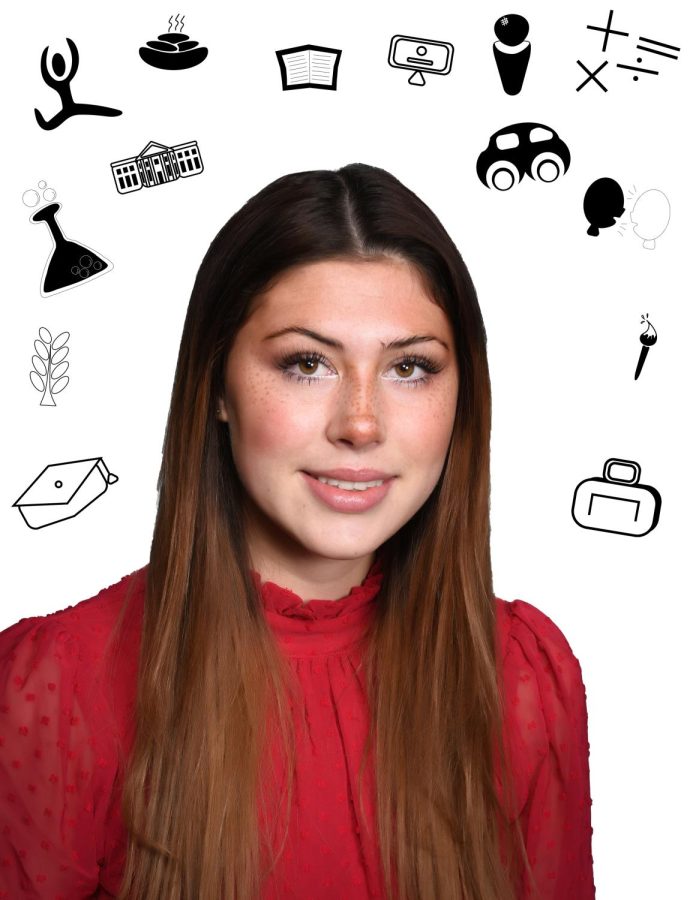Brynna Robbins: Seeing Life Through Numbers
May 16, 2023
Many people often sit through math class wondering when on earth they are ever going to use natural logs or binomial expansion in the real world. But what many don’t realize is that math is part of hundreds of different careers, though it plays a larger role in some more than others. Neuroscience and psychology might not seem obvious candidates for heavy mathematical application, but those just so happen to be two fields that Highland’s Sterling Scholar winner for mathematics, Brynna Robbins, hopes to pursue in college.
The use of math in neuroscience and psychology might not seem as obvious as, say, engineering or finance, but they certainly play an integral part in furthering research and progress in these areas.
“They are not directly math-based fields, but there are a lot of statistics involved, especially in the research side of both of those,” Robbins said.
When it’s put that way, it is easy to how math is suddenly important in nearly every career field, as collecting data and research often requires using statistics specifically to better understand what that data means and how it will help further the area of study.
Robbins’s interest in math has been reflected in several little experiences in her life from solving Sudoku puzzles to memorizing as much of pi as possible for pi day or drawing pictures on graphs using only mathematical formulas.
“I’ve always been, since I was young, just interested in solving…math equations and looking for patterns,” Robbins said.
Her talent with numbers and patterns began to show through with her participation in the Math Counts competitions in seventh and eighth grade. The competition began as a school-wide test that would later turn into a region-wide competition if one should place within the top 10 in their school. Robbins took first place for Salt Lake Arts Academy in seventh grade and second place in eighth grade as well as fourth in the region with her fellow team members.
When Robbins entered high school, she saw it as an opportunity to explore the different types of math. Robbins was only a sophomore when she took AP Statistics which was also that fateful year when a majority of the school year was online, but it did nothing to dampen her growing passion for the subject.
Robbins finds it fascinating how it’s possible to take such large amounts of data and transform them into a format that can universally be understood. Analyzing treads among data sets and being able to see this data in a visual format that is not just numbers are also things that Robbins finds interesting about this field of mathematics.
“I kind of see it as like a way humans invented to like communicate with each other in a sense,” Robbins said.
Robbins isn’t the only one in her family who felt this draw towards numbers and patterns though. In fact, it may even run in her blood according to Robbins’s mother, Kathleen Clark.
“We all sort of have math and science backgrounds in our house,” Clark said, “so it wasn’t too much of a surprise [Robbins] gravitated towards math.”
Clark herself works for the Huntsman Cancer Institute researching genetic breast cancer, and Robbins’ father works in Biofire’s coding department, so this draw towards STEM in her family is nothing new.
With the ever-increasing use of statistics and calculus and other forms of math in this technology-heavy world, a passion for numbers and puzzles is an excellent thing to have. While it may not feel like it sometimes, math is something everyone will have to use even after they leave school, be it for keeping track of finances or sending rockets to Mars.
“Being an adult in the workforce, you can see–now more than ever–math has so many applications in different fields,” Clark said.
Clark says it has been fascinating to watch her daughter not only progress along the math track throughout her schooling but succeed along the way as well. There were undoubtedly some roadblocks along the way, but Clark sees her daughter’s perseverance through those challenges and the praise from Robbins’s math teachers regarding her hard work as huge compliments to her daughter.
Math has also piqued Robbins’s interest in other fields, not enough to pursue them as a career, but more as a casual fascination; one of these fields is architecture.
“I think it’s super interesting all the math that goes into building stuff,” Robbins said. “It’s pretty impressive.”
Robbins’s life is not all about math though, as she has several hobbies that don’t require big calculations such as jewelry making and crocheting. Robbins also enjoys geocaching in her spare time which is a sort of scavenger hunt which involves finding a location where a certain item called a cache is hidden using provided clues and coordinates. Once found, the cache holds a log where you can write down your name and sometimes hold various knickknacks a person can trade out.
Robbins believes her adventures after high school will take her to UC San Diego this fall as she finds new ways to integrate math into everyday life.




























